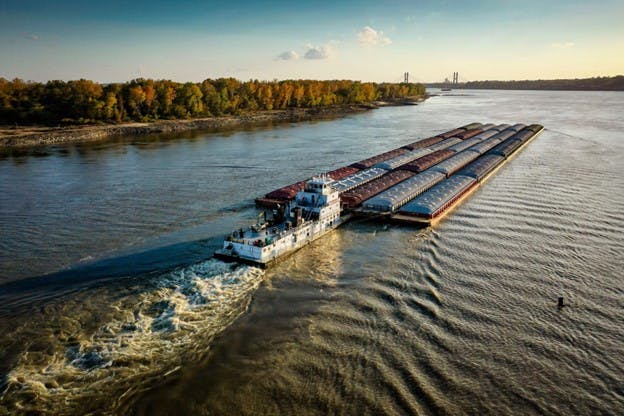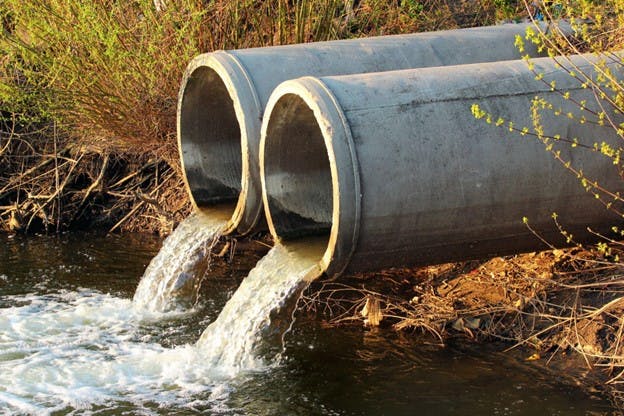🌟 New Arrival! Upgrade Your Water with Our Advanced Pitcher Filter. Shop Now
December 2023
Drinking the Mississippi: Examining Minneapolis Water Quality
Without Minneapolis, the United States wouldn't be what it is today. The Twin Cities were the first to bridge the mighty Mississippi, and this heartland city once fed Americans with the world's largest flour mills. Today, Minneapolis is known for much more. It's home to major companies like Target, 3M, and United Healthcare, as well as cultural contributions ranging from Prince to the Snickers Bar, and even beloved characters like Charlie Brown and Snoopy.
While the city of Minneapolis consistently ranks among America's top cities for quality of life, we're here to examine Minneapolis water quality. Given that Minneapolis literally means "the city of water," it has a lot to live up to.
Despite its impressive contributions, the most populated city in Minnesota still faces some pretty big challenges keeping their water supply clean. In this article we’re going to take a deep dive into what those challenges are, how they are dealing with them, and finally we’ll let you know what, if anything, you need to do to protect yourself.
Where Does Minneapolis Water Come From?
Minneapolis sources its water from the Mississippi River, which spans over 2,300 miles and passes through 10 states before emptying into the Gulf of Mexico. The city draws from a segment of the river located upstream of the metropolitan area to minimize pollution and contamination.
The river not only serves as a major waterway for commerce and travel but also provides water to more than 20 million people in various states. In Minneapolis, the Mississippi River serves as the key water source for about 420,000 residents, along with numerous businesses and industries.
The Minneapolis Water Treatment and Distribution Services, a division of the city's Public Works department, is responsible for treating and delivering clean water to Minnesotans. Each day, the facility treats approximately 57 million gallons[1] of water from the Mississippi River, ensuring it meets the drinking water quality standards of the Minnesota Department of Health and the U.S. Environmental Protection Agency (EPA).
Once treated, the water is distributed throughout the city to homes, businesses, and institutions. The division also manages wastewater treatment and removal, safeguarding both human health and the local environment.
How Clean Is Minneapolis Tap Water?
The name Minneapolis comes from the Sioux word "minne," meaning water, and the Greek "polis," meaning city. The name means "city of water," reflective of the area's abundant lakes, streams, and other surface water. However, abundance doesn't equate to quality. In fact, about half of the 83,000 miles of streams across Minnesota have been altered by people.
These alterations have led to damaged wildlife habitats and increased contaminant levels. Much of the water was initially diverted for agriculture, owing to the city's history as a major producer and miller of wheat. This has resulted in high concentrations of nitrate-based fertilizers and pesticides in rivers, lakes, and groundwater.
Minneapolis is also the birthplace of the Minnesota Mining and Manufacturing Company, commonly known as 3M. Chemicals like PFAS, which are a current concern for public water supplies, were either manufactured or invented by 3M. Though much of this manufacturing has moved elsewhere, its after-effects still impact Minneapolis' water quality.
In 2022, the State of Minnesota reported that 2,904 bodies of water are now impaired with water contaminants, including large portions of the Mississippi River. That is an increase of 305 impaired water bodies from two years prior. Most of these impairments mean aquatic life like fish and insects can’t survive due to chemicals or lack of oxygen. In the Mississippi River, nitrates and E.coli are big problems for recreational use and drinking water systems.
Before the river water makes its way to your faucet, it goes through a filtration process at a treatment plant. However, your water still might taste fishy or swampy. That’s due to decaying matter and algae blooms in the Mississippi. While the taste and smell can be unpleasant, it is still considered safe.
Is It Safe to Drink Tap Water in Minneapolis?
According to the Minneapolis Water Quality Report and the U.S. Environmental Protection Agency (EPA), the tap water in Minneapolis is safe to drink. However, meeting regulatory benchmarks doesn't necessarily mean that the water is completely safe for consumption.
In the United States, all public water systems are held to minimum quality standards defined by federal regulations. These guidelines set legal limits for approximately 90 known water contaminants. While that number might seem high, keep in mind that there are thousands of potential contaminants that are not yet regulated or understood.
Our growing knowledge about chemicals and their effects might call for an expansion of existing regulations. For example, chemicals like chromium-6 and PFAS, long present in our water, are only now coming under regulation due to new discoveries about their potential health impacts.
Even among the contaminants that are regulated, some experts argue that the allowable limits are too high for guaranteed safety. According to the Environmental Working Group (EWG), a D.C.-based nonprofit water watchdog group, current EPA regulations might not align with the most up-to-date scientific recommendations for safe drinking water.
What Chemicals Are Affecting Minneapolis Water Quality?
While Minneapolis water quality falls within legal limits for various chemical contaminants, many experts argue that these levels are still too high for comfort. Below, we'll examine how the concentration of these chemicals stacks up against current safety recommendations as outlined by the Environmental Working Group (EWG).
Haloacetic Acids (HAA5)
HAA5 is made up of five haloacetic acids: monochloroacetic acid, dichloroacetic acid, trichloroacetic acid, monobromoacetic acid, and dibromoacetic acid. These chemicals are known as disinfection byproducts, as they result from disinfectants like chlorine interacting with organic matter in water. Long-term exposure to HAA5 can lead to cancer.
Levels of HAA5 in Minneapolis water have exceeded what the EWG recommends for safety by 220 times:
- EPA maximum allowance: 60 parts per billion (ppb)
- EWG recommended maximum: 0.1 ppb
- Minneapolis maximum contaminant level: 22 ppb
Haloacetic Acids (HAA9)
HAA9 includes all of the contaminants from HAA5 but adds bromochloroacetic acid, bromodichloroacetic acid, chlorodibromoacetic acid, and tribromoacetic acid. These are also disinfection byproducts and are also cancer-causing.
Levels of HAA9 in Minneapolis water have exceeded what the EWG recommends for safety by 340 times:
- EPA maximum allowance: No legal limit
- EWG recommended maximum: 0.06 ppb
- Minneapolis maximum contaminant level: 20.4 ppb
Total Trihalomethanes (TTHMs)
TTHMs — like the haloacetic acids above — are formed when chlorine interacts with organic compounds in drinking water. They’re also known to be carcinogenic. This category is made up of four chemicals: chloroform, bromodichloromethane, dibromochloromethane, and bromoform.
Levels of TTHMs in Minneapolis water have exceeded what the EWG recommends for safety by 137 times:
- EPA maximum allowance: 80 ppb
- EWG recommended maximum: 0.15 ppb
- Minneapolis maximum contaminant level: 20.5 ppb
Chromium (Hexavalent)
Chromium is another common contaminant found in U.S. water supplies. It can occur naturally but is also an industrial pollutant. Although it’s known to be a carcinogen, this contaminant is still unregulated by the EPA.
Chromium levels in Minneapolis water have exceeded what the EWG recommends for safety by 16 times:
- EPA maximum allowance: No legal limit
- EWG recommended maximum: 0.02 ppb
- Minneapolis maximum detected level: 0.31 ppb
Nitrates
Nitrates usually end up in water supplies through stormwater runoff from fertilizers, but they can also come from septic tanks. They can cause oxygen deprivation in infants and increase the risk of certain cancers.
Nitrate levels in Minneapolis water have exceeded what the EWG recommends for safety by 2.7 times:
- EPA maximum allowance: 10 parts per million (ppm)
- EWG recommended maximum: 0.14 ppm
- Minneapolis maximum detected level: 0.377 ppm
Does Minneapolis Have Hard Water?
Hard water is very common in the state of Minnesota, but Minneapolis does not have hard water. Minneapolis water utilities remove 65,000 pounds of hardness minerals daily. While consuming hard water does not present a health risk, hardness minerals can be extremely damaging to your skin, home, appliances, and clothing.
Water becomes hard when high concentrations of calcium and magnesium dissolve into the water. These minerals can stick to surfaces and bind to soap to cause soap scum..
Is Minneapolis Water Fluoridated?
Yes. Like many other cities in the U.S. and Canada, Minneapolis includes fluoride in its water treatment process. The addition of fluoride to tap water is aimed at improving public dental health by reducing tooth decay and strengthening enamel for both children and adults.
While many residents appreciate the advantages of having fluoride in their water supply, there are others who prefer to manage their own fluoride levels. Excessive fluoride can potentially lead to fluorosis, which manifests as discoloration and spotting on teeth, particularly in young children.
For those interested in eliminating fluoride from their tap water, it's important to know that simple methods like using carbon filters or boiling water are ineffective. A reverse osmosis water filter will be needed to remove fluoride from your water.
Get the Best Quality Water in Your Minneapolis Home
Minneapolis is the city of water but it's also a city of agricultural and chemical manufacturing. While it’s done a lot to clean up its act, Minneapolis water quality isn’t quite as good as it should be.
If you want the best-tasting clean water straight from your Minneapolis tap, HomeWater can help. HomeWater's UPSTREAM 4-Stage Whole Home Water Filters can improve your water quality by removing impurities like sediment, chloramines, DPBs, PFAS, microplastics, heavy metals like chromium, and more.
Make your Minneapolis water quality better with HomeWater.


